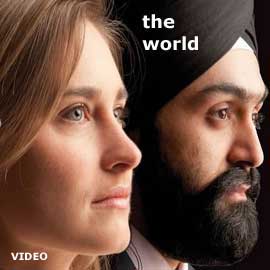Talking Stick
The Gift of Sikhi
Ardaas, Part Seven
The Talking Stick Colloquium # 39
Convenor: RAVINDER SINGH TANEJA
THE GIFT OF SIKHI
THE DIALOGUE - So Far
The Khalsa is meant to be a symbol of universal brotherhood, and in this sense the use of the term "Sarbat Khalsa" refers to all of humanity. We mentioned the fact that the passage "Prithmay Khalsa ji ji ardaas," is a political manifesto of sorts. The social blueprint of an ideal society as envisioned by Gurmat is inherent in the passage: the notion of Degh and Tegh signifying society as a collective enterprise where the public welfare is supreme.
How conscious are we as a community of the special responsibility that we carry? This has remained, alas, unanswered during our discussion and to which we should eturn.
THIS WEEK
Sikhaa(n) noo(n) Sikhi daan, kes daan rehat daan bibek daan, visaah daan, bharosa daan, daanaa(n) sir daan, naam daan, sri amritsar ji day darshan ishnaan, chau(n)kiaa(n), jha(n)day, bungay, jugo jug atull dharam ka jaikaraa, bolo ji Waheguru!
We pray for the boon of Sikhi to all Sikhs,
For the gift of unshorn hair,
And the Guru's discipline;
For Discernment, Trust and Faith;
Above all, for the gift of Naam;
May Sikhs behold the sight of Sri Amritsar,
And dip in the pool of nectar.
May the Shabad forever be our watch,
Our banners and schools
Remain forever established.
May the cause of Truth, Justice,
Righteous action - always prevail.
Glory is to Waheguru.
THE MESSAGE
This passage extends the prayer of petition further, asking for the blessings of a Sikh lifestyle. Sikhi, of course, refers to that inspired religion and way of life which flowed from the enlightenment of Guru Nanak. Guru Nanak's vision and philosophy (Sikhi) is distinct from the prevailing philosophical schools on the subcontinent, known collectively as Khat Sastar or the six systems - a fact that is emphatically made by the Guru Amardas:
"As a way of discipleship, Sikhi is rooted in humility. Discipleship assumes no knowledge and is an unending process of learning and development."
Humility is often confused for civility or courtesy, whereas in fact humility is a much deeper and core value: it is the conviction that "I" am not the creator but am part of an infinite creation; that "I" am a part of nature, not divorced from it; that "I" am not the source but a conduit or medium for the Creator.
The sin of "haumai" is the source of all error that leads us to a loss of humility. Ironically, haumai is also the process of creation - a built-in sense of individuation designed to foster a sense of the separate self in order to enable the drama of this world.
The gift of Sikhi that we petition for is the way of the Guru - Gurmat - the message of Guru Nanak. Gurmat restores us to our authentic selves by drawing us back from our innate involution from the source of our Creation.
Sikhi is impossible without Naam, the supreme gift that is asked for, not only in the ardaas, but repeatedly in the Guru Granth Sahib. While there can be no doubt as to its centrality in Sikh thought, Naam remains difficult to comprehend because it is a
gift, an end in itself, a practice and a discipline - all rolled into one.
The practice of Naam has to be accompanied by the cultivation of a lifestyle characterized by external and internal markers which are listed in the passage under study.
Kesh or unshorn hair is the source of much disputation within the community today. The ardaas, however, is quite clear on asking for the gift of Kesh. The wearing of unshorn hair has been part of all spiritual cultures since time immemorial and across all major faith traditions.
Rehat brings to mind (at least for most of us) the Sikh Rehat Maryada or the Code of Conduct - which, like the Kesh, has become another contentious topic within the community today.
The adoption of external insignia (the 5K's) is only one dimension of the Sikh rehat. It must be anchored in an equally important - if not more - internal rehat, or atam di rehat, as it is referred to in gurbani. The inner rehat provides the framework and basis for authentic and radical transformation through an apprenticeship to the Guru.
This necessitates the cultivation of a certain moral, social, political and aesthetic attitude, an attachment to a certain liturgy and an appreciation for certain kinds of feelings associated with the religion.
Bibek daan, visaah daan, bharosa daan ... refer to the inner qualities or virtues that must accompany the practice of Naam.
Discernment is a Christian term that has been used here for bibek because I think it is quite similar. In Christianity, discernment refers to the quality or process of being able to grasp God's Will in relation to one's life - heeding one's calling, paying attention to moral imperatives and so on.
For a Sikh, "hukam rajaa-i chalna" has similar connotations. In a specific sense, bibek also means the ability to see the One behind a seemingly multitudinous and conflicting existence.
Visaah and bharosa are related terms meaning trust and faith, both necessary requirements for a spiritual life.
The passage also pleads for institutional well-being - another reminder that Sikhi is not just about the individual.
The prayer for 'Sri Amritsar ji day darshan ishnaan' signifies more than the emotional homesickness of Sikhs who were on the run from Mogul authorities.
Amritsar is a model or prototype, if you will, of an inclusive cooperative society that Guru Nanak envisioned and Guru Ramdas and Guru Arjan built - the Sikh version of the Christian City upon a Hill or the American idea of God's Country.
Chau(n)kiaa(n), jha(n)day, bungay ... (translated respectively as watches/ protectorates, banners/ flags and centres or schools), collectively symbolize the institutions needed for the Faith to flourish: dharam ka jaikaar.
Chau(n)kiaa(n) is plural for Chau(n)ki and is a term commonly used for a toll site or military cantonment, but in this context the word means to be on guard - hence the word "watch" used in the translation. The idea is to be in a state of constant wakefulness against intruders, both internal and external.
In Sikhi, Shabad is the guardian under whose watch Sikhs live their lives. At Harmandar Sahib, the tradition of being in constant wakefulness is symbolized by the five watches or chaunkees that were established by Guru Arjan and continue to this day: Asa di Vaar, Bilawal di chaunki, Charan Kanwal di Chaunki, Sodar di Chaunki and Kalyan di Chaunki.
Jhaday - banners or flags. The Nishan Sahib or triangular flag that flutters outside every Sikh gurdwara symbolizes Khalsa's sovereignity and independence and belief in the One Universal God and has evolved through Sikh history. One school of thought is that the flag represented a battle standard, although it appears that Guru Amardas had a white triangular flag hoisted at Goindwal. At the Akal Takht, two flags fly from the same platform, signifying Miri and Piri - the dual responsibilities, the Secular and the Religious, of each Sikh - indicating that in Sikhi, there is no compartmentalization; there is to be a balance between nthe two spheres of daily life.
Bungay derives from Persian and, literally translated, means a structure representing a dwelling. Historically, these were traditional dwellings from where various traditions associated with the Panth were nourished and perpetuated. In Amritsar,
there are six different types of Bungas: Gianian de Bungey, Raagian de Bungey, Akaalian de Bungey, Sampradaye Bungey, Sardaran de Bungey, and Dharam Bungey.
LET'S PONDER TOGETHER
In the first part of this passage, Sikhs petition for the gift of Sikhi or the Sikh way of life, which is enabled by adoption of the discipline of Naam and characterized by an inner and outer rehat.
Naam is confusing because gurbani uses it in various contexts but does not offer a systematic explanation. The question is: Is the mechanical repetition of the term Waheguru part of Naam? If yes, then will any word (or sound) do?
If Sikhi is a life style (and I believe it is), then it must include a social and political element as well. In the discussion last week an attempt was made to initiate a discussion around this. Let us continue that discussion by asking ourselves: What kind of society or social process is compatible with a Sikh life?
- Capitalism is the preferred mode of economic organization today and democracy its social and political attendants. How does this jive with the vision of our Gurus?
December 5, 2010
Conversation about this article
1: Mohan Singh (Toronto, Ontario, Canada.), December 06, 2010, 8:06 PM.
These are seven steps, Sikhi, Kesh, Rehat, Bibek, Visah, Bharosa and on top of it Naam daan. Here, Naam daan is always by the grace of Almighty Waheguru, that is why it is "daana sir daan Naam daan". Here again, Naam is Wahwguru and Waheguru is Naam. "Daana sir daan Naam daan" is God's grace with strength, courage and tolerance to live in His Hukam.
2: Inderpreet Singh (Chelmsford, MA,, U.S.A.), December 11, 2010, 1:58 AM.
As with all aspects of the ardaas, I feel there is an element of the "double sovereignty" principle also present in the "Sri Ammritsar ji de ishnaan ..." and other sections of the ardaas. I personally interpret this line as a reiteration of the free and constant access to the center of Sikh political and spiritual authority - the Darbar Sahib complex (already related in the original post). Secondly, it is also a re-interpretation of the idea of dipping in the ambroisa-like Naam which is the life transforming Divine inspiration that all Sikhs must acknowledge and adopt. By including both (or multiple) interpretations of each line, we possibly get a more holistic view of the intent of our ancestors that collectively penned this memory and etched it in our inner beings. Finally, just a minor (but significant) nit-pick and a question - the sample ardaas from the Sikh Rehat Maryada does not mention "darshan ishnaan", it only mentions "Sri Ammritsar ji de ishnaan ...". It is habit-based on certain family or community traditions to also include "darshan". I have an idea of why it should only be ishnaan, but wanted to ask if there is a reason "darshan" was excluded. Any thoughts.
3: Ravinder Singh Taneja (Westerville, Ohio, U.S.A.), December 12, 2010, 11:26 AM.
You raise an interesting question, Inderpreet. Depending on the source or the individual offering the ardaas, I have seen both "darsan, ishnaan" used, although you correctly point out that the ardaas contained in the maryada mentions only "Sri Amritsar ji ke ishnaan." Dr Jaswant Singh Neki in his book captions his treatment of this passage as "Sri Amritsar ji ke darshan ishnaan," although some pages down is the "Panth Pravinik" ardaas without "darshan." It would be interesting to hear some thoughts around this. Let's continue this discussion in the next week.



